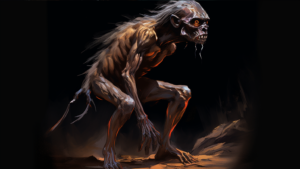Navajo culture says that a skinwalker is a dangerous witch who can change into an animal, take it over, or hide herself.”By means of it, it goes for every fours” is what yee naaldlooshii means in Navajo. There are different kinds of skinwalkers among the Navajo people. Still, yee naaldlooshii is one of the best-known Navajo ideas among people who don’t know much about them because it shows up so often in scary books.
Skinwalkers and other Navajo witches are very different from what the Navajo traditionally believe. Community healers and cultural workers have been called medicine men and women, or other positive, healing names in the local language. On the other hand, witches were thought to be evil because they held strange celebrations and used magic to do bad things instead of the good things that medicine people usually do. Therapists who work in the traditional way learn about good and bad magic so they can do their job well. Even though most people are up to the task, some may give in to evil and become witches.
This huge, boring country didn’t have any main religious beliefs, so it was kind of like a blank slate when compared to other places. In other words, there isn’t a single, truly unique theistic religion. In addition, most indigenous groups ran their own separate autocracies. Each group had its own set of customs, ways of organizing work, and way of running the government. Because of this, there was no Empire. There are no Ottomans, British, or Spanish people; only small groups of people who roam around and sometimes move from place to place. When the Europeans came, there was a time of chaos. Dutch, French, British, and Spanish monarchies made up the United States. Everyone and their grandma was interested in them.
When we started telling and hearing indigenous stories, things started to mix together and get better. From Old Stormalong and Paul Bunyan to the Llorona, the Loveland Frogman, the Lusca, and everything else Lovecraft wrote… The Navajo belief in a BIG BAD Boogieman, though skewed, is one of the old stories that lived on, came back to life, and became culturally important in modern times.
According to some stories, a medicine man’s sin changes the natural order of things, which leads to the creation of Skinwalkers. The doctor, who used to be good, has become evil and been promoted to Sith Lord. Because of the toxins in the air, they have superhuman powers. Different cultures have these skills in different ways. The Sith Lord can now control another beast, change into other animals, and take over other clan members after going through this evil change. In some cultures, committing a big social sin can turn anyone, of any age, into a skinwalker, just like the wendigo curse.
The story of the skinwalkers isn’t well known outside of Navajo society because people don’t like talking about it with outsiders and people who write about it don’t have much personal experience with it. Traditional Navajos are hesitant to tell skinwalker stories to people from other groups or to talk about important issues with people they don’t know and trust. Someone from the Cherokee Nation named Adrienne Keene runs the blog Native Appropriations. She wrote that when non-Navajos use legends in their work, “we as Native people are currently opened up to a barrage of questions about those beliefs and traditions.” But those aren’t things that should or should not be talked about with strangers. Not at all. I understand that this might seem “unfair,” but it is necessary for our societies to stay alive.
Animals that are usually associated with witches are tricksters, like the coyote. Other animals, usually those that are linked to death or bad luck, may also be included. They might also take over other critters or people and move around in their bodies. Both men and women can become skinwalkers. Navajo children’s stories about skinwalkers can range from full-on fights where one person dies to draws where neither person wins. They might write encounter stories in the form of victorious stories, in which the skinwalkers are pushed out of a hogan. The roadside encounter story is the most common way that non-Native writers tell skinwalker stories. In this type of story, the main character is briefly vulnerable to the skinwalker but eventually manages to escape in a way that isn’t common in Navajo stories. In Navajo children’s versions of European folktales, skinwalkers are often used instead of more common killers like the Hook.






